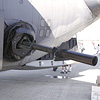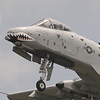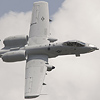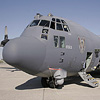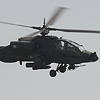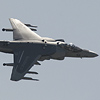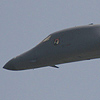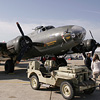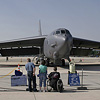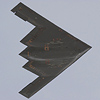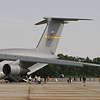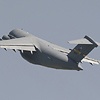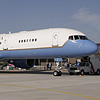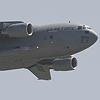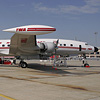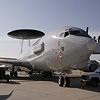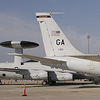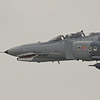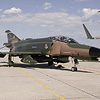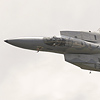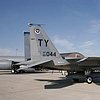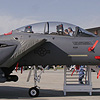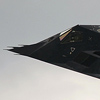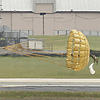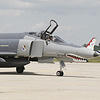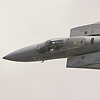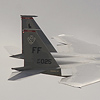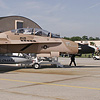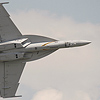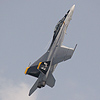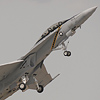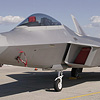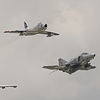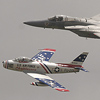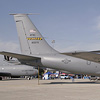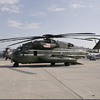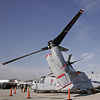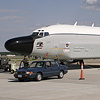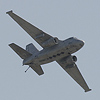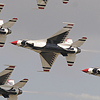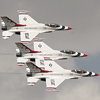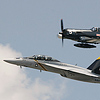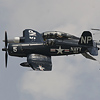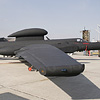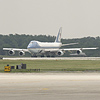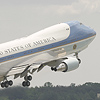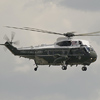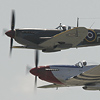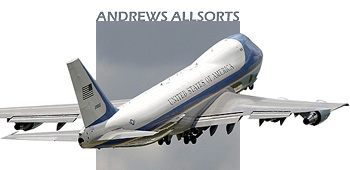
Joint Service Open House 2005 Review
Sunday 8th October
Every year, when I'm in the process of selecting which airshows I'll try to attend, there are many issues that cross my mind. Some are not airshow-related, like whether I'll have enough money available to pay for my trip expenses, or whether I'll manage to obtain enough days off work to go where I need to. On the other hand, and equally important, I try to anticipate what every show will have in its lineup, and what events have a good chance of fulfilling my expectations of what a good show should be. Based on these criteria, I chose to attend NAS Oceana last year, and obviously was not disappointed with that choice (duh!). This year, the Department of Defense/Joint Service Open House got the nod on May 21-22, and, once more, I'm happy to have selected an excellent airshow to cover for UKAR, as you'll see below.
reviews the 2005 Department of Defense/Joint Service Open House. All photos by the author.
The DoD/JSOH 2005 can be described, in short, as a top-notch event. From the parking facilities to the shuttle transportation system (which was absolutely superb) to the varied displays both in the air and on the ground, there was hardly anything to complain about. Even the weather, which at first seemed to spell doom for the airshow (it rained all day on Friday, and this airshow has a history of being rained out), cooperated during the weekend, although there were plenty of clouds each day during the afternoon. Having attended RIAT, Duxford and Old Warden in the past, I can tell the weather was excellent compared to the one usually found at UK airshows, to say the least (where getting "Kembled" is always a possibility)...
Probably the biggest surprise I experienced during the weekend (and something I swore on our message board it would never happen to anyone) was the fact I was the very first person to arrive at the inspection tents not only on Saturday, but both days! What made it even more surprising was the fact I didn't really arrive early if you use RIAT standards, for example (0630 Saturday, 0650 Sunday). Of course, after my gear was inspected, I boarded the first shuttle to the base, and was able to take pictures before the huge crowds arrived (a million people were expected over the weekend). Even though some don't particularly like off-base parking, JSOH 2005 should be an example of how effective it can be, since there were no traffic delays on either day. It might be very expensive to operate so many shuttles (and there were at least a hundred of them), but they were able to handle the crowd with flying colours. Very impressive!
The static displays were neither as interesting nor as diversified as the website led us to believe they would be (of notice was the small number of fighters on display), but that's something expected to happen most times these days. The main absence in 2005, and one deeply lamented by everyone, was of the F-14 Tomcat, a sight that is becoming rarer and rarer at airshows. Now in what it seems to be its last year of operational service, an F-14 appearance must never be taken for granted, but I wasn't lucky enough to see it this time. Fortunately, other static displays were exciting enough to fill that void, particularly the MV-22 Osprey (first time I've ever seen one in the flesh) and a Langley F/A-22 Raptor, which had been delivered to its squadron (27th FS, 1st FW) just 10 days before.
Other static displays worth of mention were the AC-130, QF-4, B-52H, B-1B, U-2, F-117, RC-135, E-3 AWACS, E-8 J-STARS, C-5, an aggressor F/A-18D from VFC-12 "Fighting Omars", a VC-32A (military version of the Boeing 757), a civilian DC-10 used in the ballistic missile defense programme, the presidential MH-53, MH-46 and VH-3, and a Lockheed Super Constellation wearing TWA colours, which took part in the movie "The Aviator".
The flying displays started each day with a performance by Allen C. Smith III's L-39 Albatros. Although he tried his best, the L-39 is not a particularly exciting airplane, and the display was a tame one. Mr. Smith has plans to re-engine his Albatros with a more powerful turbine as used in the L-159, the light attack version now being manufactured in the Czech Republic. Maybe, with the additional thrust, he'll be able to expand his routine, which suffers nowadays from a lack of power provided by the L-39's current engine.
The AH-64 display was next, and it was flown not by one Apache, but two of them. But this performance, together with all the others performed during both mornings, was hindered by the fact the sun was directly in front of the public, which made observing the displays difficult, never mind taking pictures of them! The Apache duo performed mostly fly-bys in front of the crowd, and didn't showcase the AH-64's considerable abilities. Much more spirited than the Apaches were the S-3 Viking duo (from VS-30), whose display was probably the best one in the morning. The Viking is a surprisingly nimble aeroplane, able to perform most maneuvers one can think of. Although S-3 Viking #604 was not able to fly on Saturday, on Sunday it took off together with Viking #610, and the full performance was staged. This is definitely a demo most airshow enthusiasts should look forward to watching, since it combines a good routine and an airplane rarely seen in the skies, and one I do recommend to anyone!
A P-51D Mustang and a Supermarine Spitfire provided the airshow a warbird display by arguably the two most important fighters the Allied countries flew in WWII over Europe. Again, something most enthusiasts have noticed at RIAT happened at Andrews AFB – the flightline is just too big for warbirds, and they were flying too far from the public. This problem was magnified when the Flying Farmer, Charlie Kulp, took to the skies. Although his Piper routine looks fine at smaller venues, it was gobbled by the vast expanses of Andrews. The Skytypers team managed somewhat to cope with this issue by proving six T-6s (five on Saturday), which flew in formation and performed some nice breaks, but did not write any messages in the skies (unlike what happened at Oceana). The Golden Knights, which followed these displays, was able to provide much more excitement to the crowd simply by landing with their parachutes closer to the public. Even though I'm not a big fan of parachute teams, it's always amazing to see all jumpers land at the same spot all the time – a credit to both men and the technology employed in manufacturing the latest state-of-the-art parachutes.
Military flying demos started with a T-6 Texan II in the morning, provided by the East Coast Demo Team. Although the schedule had the T-6 set to perform a Heritage Flight with Kevin Russo's T-6/SNJ, the latter, for some reason, never left the ground during the airshow. The USAF C-17 Globemaster III did leave the ground both days in impressive fashion, and its size and agility never fails to impress. The C-17 not only provides the USAF with an aircraft capable of ferrying C-5 loads while operating on C-130 strips, as the narrator stressed a couple times, but gives the public a chance to see a Galaxy-sized aeroplane perform Hercules-like maneuvers! The Marine Corps´ AV-8B Harrier from the East Coast Demo Team also was available, and flew its usual routine composed of a short take off, two fast passes, several hovering maneuvers, a vertical landing, a vertical take off (something RAF and RN Harriers never do, and something that shows the Harrier amazing power), a few more hovering maneuvers, and finally another vertical landing.
On Saturday only, the two resident VC-25s (one of them being Air Force One, since US President George W. Bush was inside – he arrived in a VH-3 and was supposed to make a speech before boarding, but never did) took off together around noon, and returned soon after the show was over. Exclusively on this day too, a B-2 and a B-1B performed three passes each before leaving to perform over different sites. While nothing spectacular is expected from the Spirit (only having the chance to see it is usually enough), the Bone displays are getting tamer by the day, with only one relatively high fast burner this time. Are we destined to never more see a B-1 perform high-G turns and rolls like the ones were accustomed to see in the past? Even the F-117A, whose performance usually comprises only a few straight passes, provided a much more spirited display, at least on Saturday. And, to the delight of all photographers at Andrews AFB, it did perform a topside pass, something one probably will never see at the other side of the pond...
On the other hand, the F-15C East Coast Demo team, whose display this year is flown by Capt. Jason Costello, provided plenty of high-speed maneuvers. Something that most photographers are now aware of, and which provides great photo opportunities, is the new 'banana' or Dedication pass, whose name derives from the fact the airplane performs a turn that resembles a banana, exposing its topside. Equally impressive, and now including the banana pass, was the A-10 East Coast Demo Team performance, flown this year by Capt Jeff Yost. A QF-4 and an F-86, flown respectively by Lt. Col Jerry Kerby and Dale Snodgrass, joined the F-15 and A-10 to perform a most memorable Heritage Flight. It is always nice to see a Phantom back in the air in the US, but it was even nicer to see it flying together with its predecessor and successor. Hopefully this initiative will not last only this year, since it is one of the greatest ideas anyone has had in the airshow business lately.
But the star of the show, once again, was the superb F/A-18F Super Hornet, whose demonstration is on a par with anything provided by any other country in the world, including the Russians and their MiGs and Sukhois. Performed this time by the East Coast Demo Team using the Jolly Rogers´ new CAG Super Hornet #103, and flown by Lt. Ian Burgoon and Lt. Craig Bangor, it flew almost the same routine that amazed everybody that saw it at RIAT and Farnborough last year. The US Navy has these days the upper hand where US airshows are concerned, since the two most desired US demos are both provided by their aeroplanes (F-14 Tomcat and F/A-18F Super Hornet). This situation will change next year when the new F/A-22 is finally allowed to perform, but these days most enthusiasts go to airshows in the US looking forward to see the Navy boys in the air.
Before the great finale, provided by the Thunderbirds, Frank Ryder's Oreck XL and the USAF Reserve Jet Car, driven by Scott Hammack, raced each other, the victory always belonging to the latter. I have to say I always liked to see Mr. Ryder's displays, but this year he was bested by Nancy Lynn and her Extra 300, who performed earlier during the show, and flew tighter and more creative maneuvers. The Thunderbirds, by the way, flew only five-ship performances during the weekend, since Thunderbird #3, Maj. Brian Burns, had received a medical discharge, and was not available for the show. Everyone could see that their formations suffered quite a bit from that absence, and that the team was not sharp at all. Hopefully things will get back on track quickly enough, and the public will be able to enjoy the Thunderbirds at their best again.
And that was the show. I had high expectations, and they were mostly fulfilled, although the promised F/A-22 participation in the Heritage Flight didn't happen (it never left the ground). I'll probably go again next year, and so should you, if you wish to attend a great airshow in the USA.

